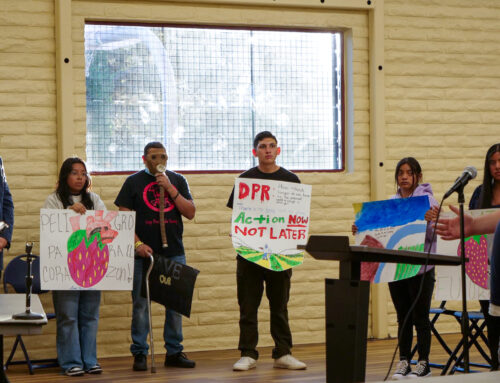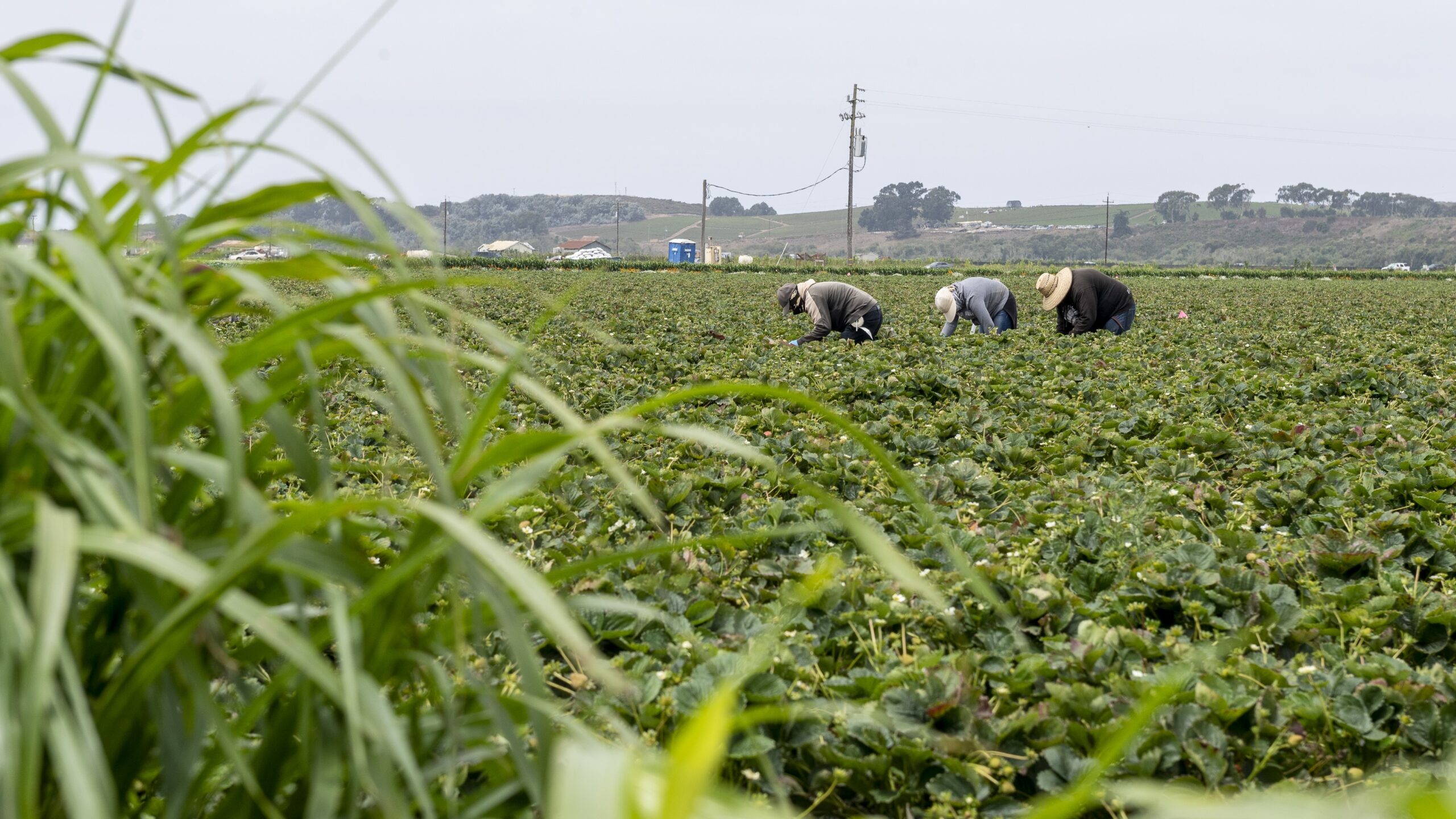
Farmworkers pick strawberries near Watsonville in August 2020. (David Rodriguez — The Salinas Californian file)
Key takeaways
- A Santa Cruz Local analysis found that potentially harmful pesticides were applied hundreds of times near South County schools from May 2022 to May 2023.
- It’s illegal to apply fumigant pesticides within a quarter-mile of a school during school hours. On parts of fields just outside of that distance, growers legally applied fumigants during school hours.
- Activists advocated for a phase out of pesticide applications to help protect children and farmworkers from respiratory problems and cancer.
WATSONVILLE >> New data show which schools in south Santa Cruz County were exposed most often to pesticide use in recent years.
Growers applied potentially harmful pesticides near Pajaro Valley schools more than 400 times from May 2022 to May 2023, according to a Santa Cruz Local analysis of county records. These are pesticides listed under California’s Proposition 65, a state law that requires businesses to provide information about potential exposure to chemicals linked to cancer, birth defects and reproductive harm.
The schools with the most-frequent applications of these potentially harmful pesticides within a quarter-mile were Bradley Elementary School, Alianza Charter School and Watsonville Charter School of the Arts, with over 100 uses from May 2022 to May 2023.
Farms and pesticide use are concentrated around South County, while North County has much less pesticide use, according to data from the California Department of Pesticide Regulation.
More than 80% of children in Pajaro Valley Unified School District are Latino and 34% of the county’s population is Latino. Ann López, director of the Center for Farmworker Families, called this disproportionate exposure to pesticides “environmental racism, pure and simple.”
Why pesticides are used
Many growers in Pajaro Valley rely on pesticides to help prevent plant diseases, boost crop yields and control weeds. Pesticides around Pajaro Valley schools were primarily used for berry crops and plant nurseries. Berries are Santa Cruz County’s largest agricultural commodity, with strawberries worth one-third of the county’s crop value in 2022, according to county records.
Some growers used chloropicrin, which can irritate the eyes, lungs and skin, studies have shown. Some growers also used 1,3-dichloropropene, which the Environmental Protection Agency classifies as a likely cause of cancer.
- There were nearly 7,000 pesticide uses within a quarter-mile of schools in south Santa Cruz County and north Monterey County from May 1, 2022 to May 6, 2023, according to county records.
- In 459 uses, the pesticides were listed under Proposition 65. Pesticides with multiple active ingredients were disaggregated into separate applications to account for each chemical separately.
On berry fields, gaseous pesticides known as fumigants often are injected into the soil. Plastic tarps usually prevent the gasses from contaminating the air, although strong winds sometimes disrupt the tarps. Activists are most concerned with fumigants, as those chemicals can disperse far away from their origin and linger in the air.
- From May 1, 2022 to May 6, 2023, fumigants accounted for less than 0.5% of the pesticides used near Pajaro Valley schools — but they included 1,3-dichloropropene and chloropicrin, which are banned in the European Union.
- During that same period, fumigant pesticides with 1,3-dichloropropene were used nine times and chloropicrin 18 times around eight Santa Cruz County schools: Lakeview Middle School, Pacific Coast Charter School, Secret Garden Preschool, Watsonville/Aptos/Santa Cruz Adult Education and Amesti, Bradley, Ann Soldo and T.S. MacQuiddy elementary schools.
Smaller growers such as Ortiz Jr. Farms and larger operations like RBF Blackberry — a grower for Driscoll’s — applied the pesticides, records state.
More than 4,000 gallons of 1,3-dichloropropene and over 5,000 gallons of chloropicrin were applied near local schools from May 2022 to May 2023. Use of the two chemicals included more than 350 gallons at Bradley and over 200 gallons near Alianza and Watsonville.
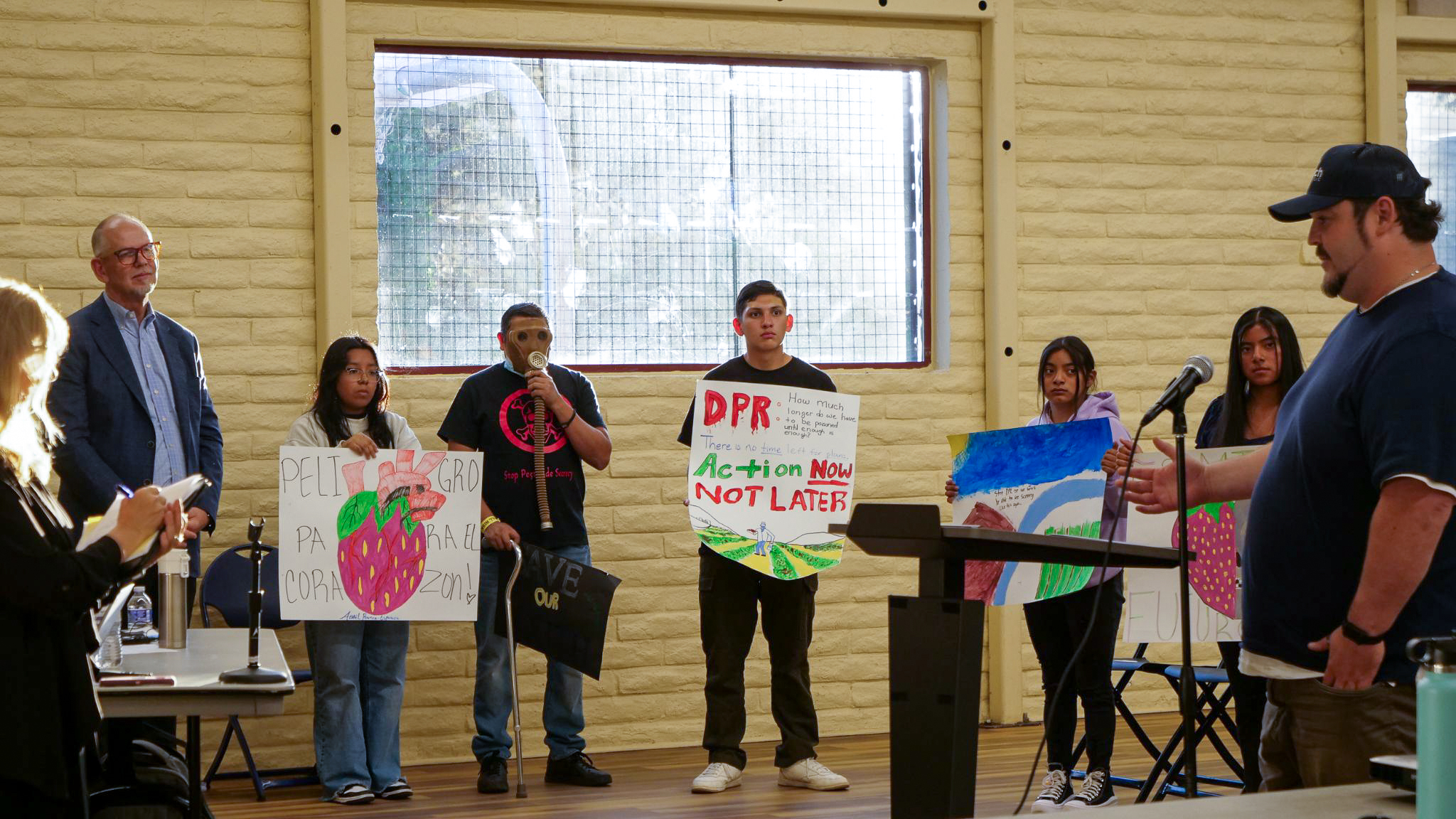
Students from Safe Ag Safe Schools’ Future Leaders of Change protest a draft strategic plan of the California Department of Pesticide Regulation at a meeting in Watsonville in October 2023. The draft plan included more transparency about pesticide use, worker safety improvements and efforts to reduce reliance on pesticides. Some critics said the plan was too vague and too slow to reduce health problems linked to pesticides. (Andrea Tamayo — Santa Cruz Local file)
Large quantities of these chemicals are required to sterilize the soil in an entire field, according to Robert Gunier, associate director of UC Berkeley’s Center for Environmental Research and Community Health.
David Sanford, the Santa Cruz County agricultural commissioner, said “pesticide use near schools within Santa Cruz County is quite low.” Small quantities were applied on agricultural areas near Watsonville Charter, Alianza Charter and Bradley Elementary, making the overall cumulative amount low, Sanford said.
The pesticide applications happened predominantly outside of school hours, in line with state rules introduced in 2018. Those rules prohibit growers from using fumigants, aircraft and several other application methods from 6 a.m. to 6 p.m. Monday through Friday.
Some growers have fields where a portion is within a quarter-mile of a school and another portion of the field is farther, Sanford wrote in an email. For instance, R. Montanez Farms, Ortiz Jr. Farms, and Alta Vista Farms legally used fumigants while school was in session on the portions of their fields that lie outside the quarter-mile radius, county officials wrote.
Fumigants were used on parts of Alta Vista Farms’ Holohan Ranch that are more than a quarter-mile from Pacific Coast Charter School at 294 Green Valley Road in Watsonville, for example.
Additionally, almost 60% of applications took place in plant nurseries, which Sanford said was safer because they are enclosed or semi-enclosed. The lack of air movement at nurseries also can make the risk greater for nursery workers, said Margaret Reeves, senior scientist at Pesticide Action Network.
Pesticide use near South County schools
A Skagit Horticulture plant nursery is at 110 Whiting Road near Watsonville Charter School at 75 Whiting Road and Alianza Charter School at 115 Casserly Road. Proposition 65 pesticides were applied at the nursery 174 times from May 2022 to May 2023. There were 1,242 total applications during that time, records state.
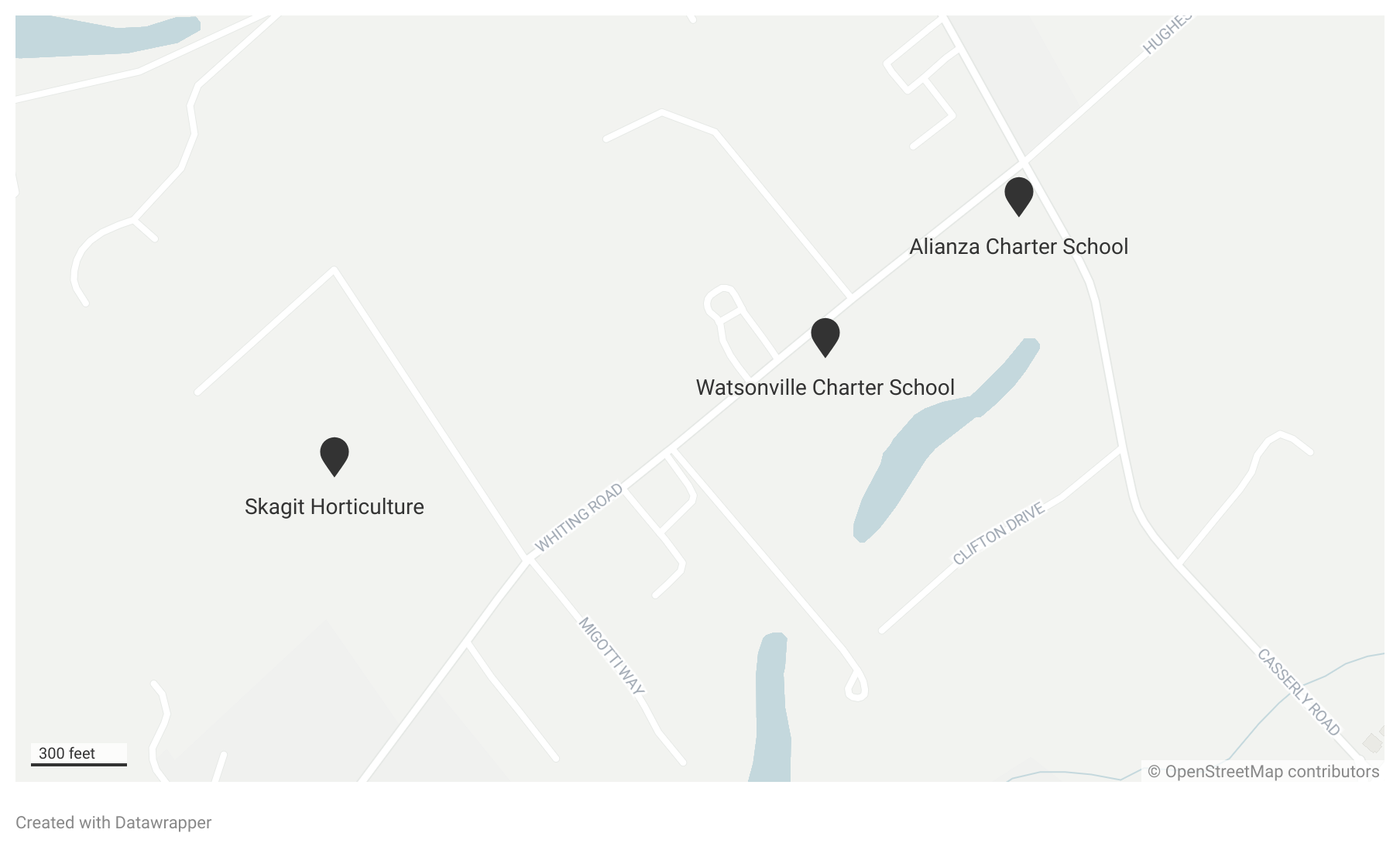
Pesticides are applied at Skagit Horticulture within a quarter-mile of Watsonville Charter School and Alianza Charter School on Whiting Road. (Map by Nik Altenberg — Santa Cruz Local)
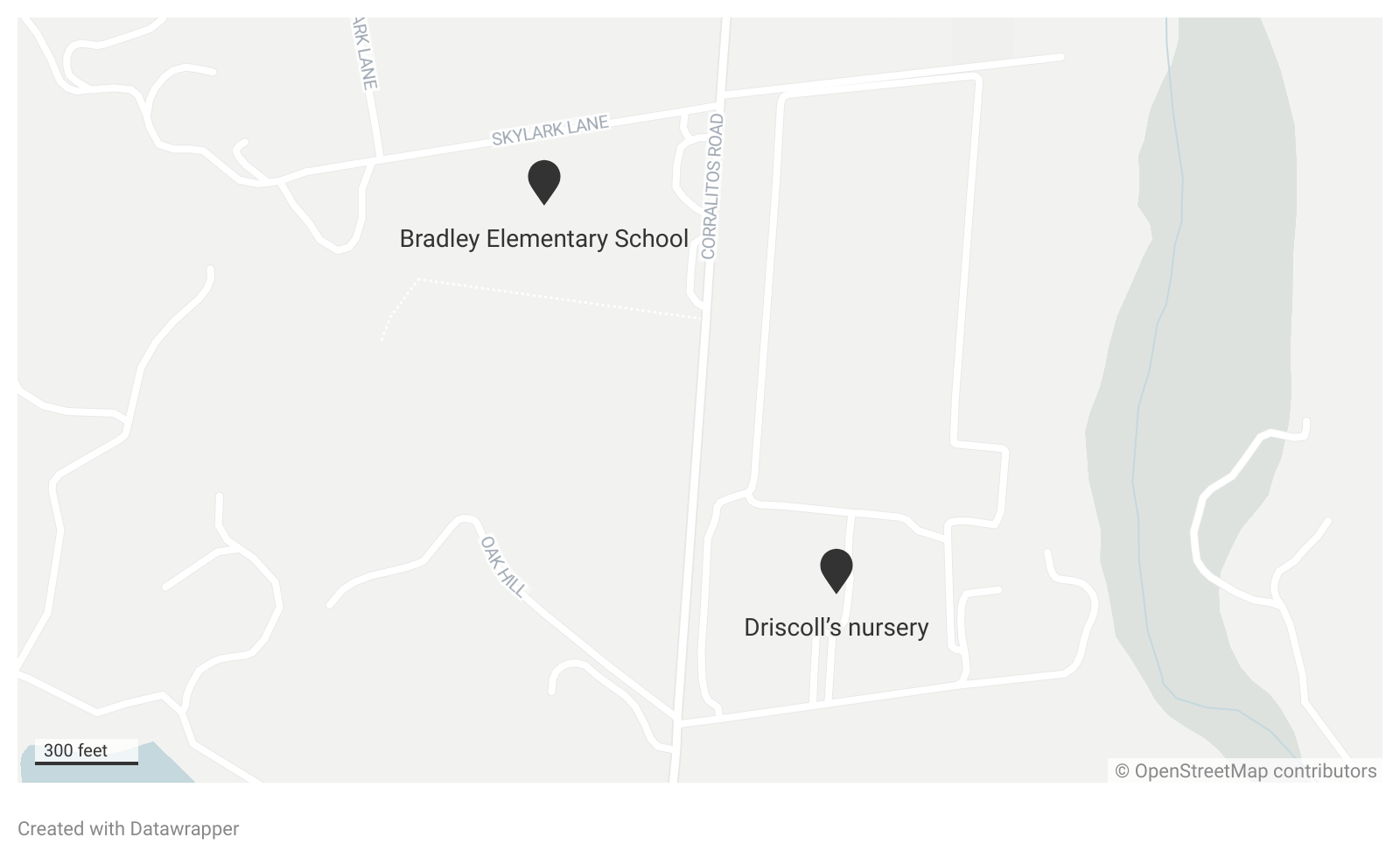
Pesticides have been applied at a Driscoll’s nursery within a quarter-mile of Bradley Elementary School on Corralitos Road. (Map by Nik Altenberg — Santa Cruz Local)
Driscoll’s Corralitos Ranch nursery is at 242 Corralitos Road, not far from Bradley Elementary School at 321 Corralitos Road. In the same time period in 2022 and 2023, Proposition 65 pesticides were applied 116 times out of 3,097 total applications.
Valued at $3 billion in 2021, Driscoll’s controls about one-third of the U.S. berry market, according to news reports.
“If anybody is in a position to go organic,” said Adam Scow, “it’s Driscoll’s.” Scow is a co-founder of the Campaign for Organic and Regenerative Agriculture. He’s also a trustee of the Pajaro Valley Unified School District.
Driscoll’s representatives said their operations were all within the law. “Driscoll’s operations including our Corralitos Nursery strictly adhere to all federal, state and local laws and regulations governing pesticides,” wrote Solana Tanabe, in an email. Tanabe works for the public relations firm Allison Worldwide and wrote on behalf of Driscoll’s.
Representatives of Skagit Horticulture did not respond to requests for comment.
Jovita Molina, who has worked as a library media technician at Alianza Charter School for over 20 years, said regulators should stop growers from using conventional pesticides near schools. “It’s just greed. Greed keeps them from making these changes,” Molina said.
Others with ties to agricultural work said pesticides should be phased out to protect workers’ health.
Alex Rocha-Álvarez grew up in the Jardines del Valle housing complex for agricultural laborers near Pajaro. Banning pesticide applications near schools would be a good first step for increasing regulations, Rocha-Álvarez said, but phasing out pesticides completely and shifting to more organic operations would be preferable.
“We need to rethink how we want to protect the people who are working in the fields,” Rocha-Álvarez said. “People who are laboring in these fields, oftentimes like 10, 12 hours a day, don’t have to be exposed to this as part of their workplace hazard.”
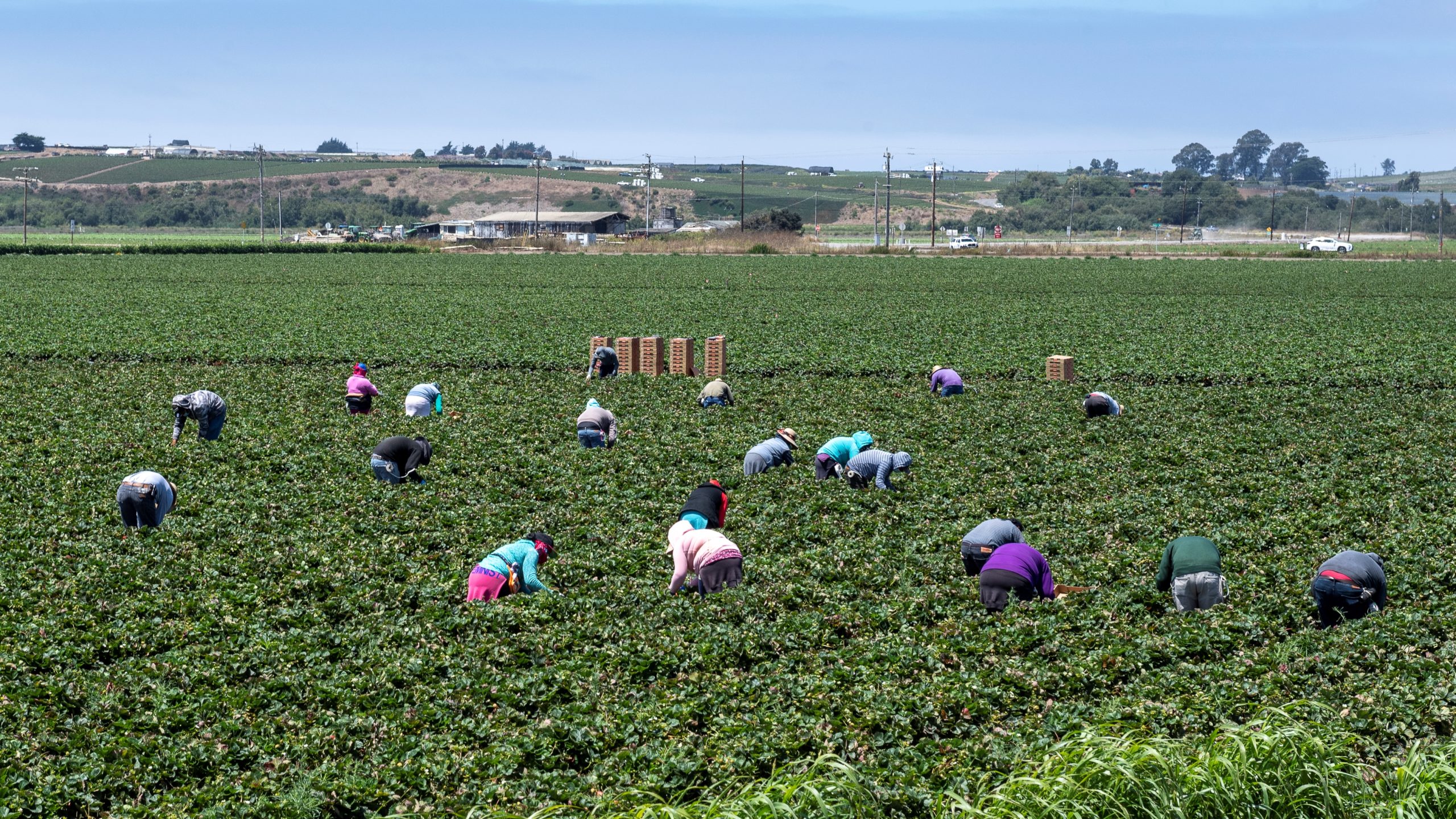
Farmworkers pick strawberries in Watsonville in August 2020. (David Rodriguez — The Salinas Californian file)
Decline in pesticide use and reported illnesses
Reported illnesses related to pesticides have declined in recent years in Santa Cruz County, though activists and academics say many cases go unreported due to fear of reprisal and unfamiliarity with the process of reporting these cases.
In 2017, there were 76 reported illnesses from agricultural pesticide exposure from farmworkers and pesticide applicators in Santa Cruz County, according to state regulators. Reported illnesses dropped to one case in 2018 and eight cases in 2019, state records show. More recent information was unavailable.
From 2017 to 2022, pesticide use in Santa Cruz County declined in part because of stricter county rules and some conversions to organic operations.
In 2022, organic agriculture accounted for 18% of the county’s $667 million agriculture industry. However, barriers still remain for transitioning more growers to organic practices. Most agricultural land in the county is leased by growers annually based on predicted needs and demands.
Fields used for conventional farming need three years to be transitioned to organic farming, which can make it difficult to establish organic operations.
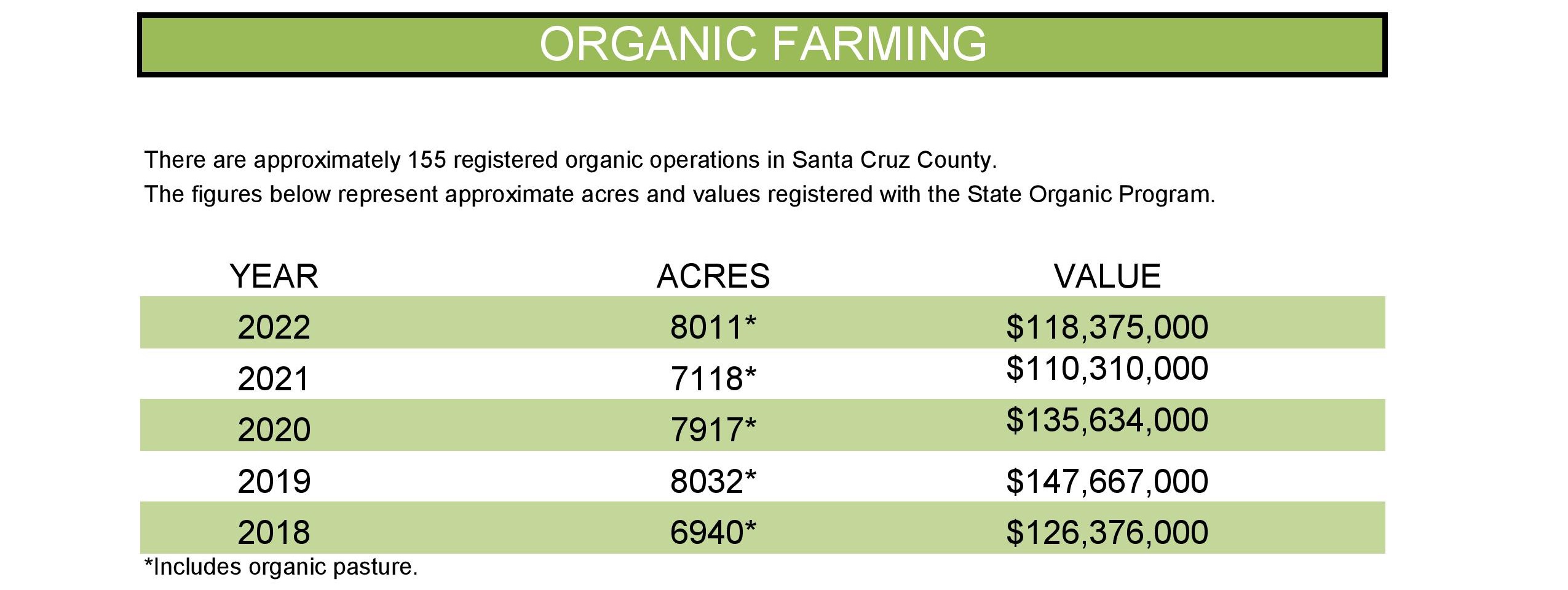
Organic farm acreage in Santa Cruz County rose from 2018 to 2022. (County of Santa Cruz)
The limits of pesticide notices
Growers are required to send nearby schools a letter listing all of the pesticides they plan to use the following year. Additionally, each instance of pesticide use is noted in pesticide use reports filed with the agriculture commissioner.
At Lakeview Middle School, Proposition 65 pesticides were used 31 times from May 2022 to May 2023, records state. Lakeview’s principal, Kathryn Kriscunas, said she supported alerts to school communities when nearby growers use pesticides.
“An important piece is advanced and timely pesticide use notice to our staff and families so we can all take steps to protect our health and avoid exposure to hazardous materials,” Kriscunas said. These notifications are issued through the portal CalSchoolNotify, though several local parents said they had not received notifications.
A focus on notifications rather than the growers’ use of pesticides shifts the burden of responsibility on individual families and school staff, according to UC Santa Cruz research.
Simply increasing access to notifications is not the solution, said Scow, one of the activists. When a pilot program was launched in 2022 to notify residents of nearby senior communities of pesticide use, he said many residents became overwhelmed by the number of notifications and were not given the necessary information to properly understand or respond to them.
Notices allow residents to take simple precautions like shutting windows that can reduce exposure and potential harm from pesticide drift. But the impact of the notices is limited.
“Just imagine yourself in that situation,” Scow said. “What are you going to do, stop breathing?”
To report a suspected pesticide-related illness to state authorities, fill out this form.
Read more
- Students protest pesticide proposal in Watsonville — Nov. 1, 2023
- Pesticide use near schools prompts calls for more transparency in Santa Cruz County — Jan. 28, 2022
David Rodriguez of the Salinas Californian contributed photos to this story as part of a package produced for the COVID-19 Information Hub at LocalNewsMatters.org. The Info Hub is a collaborative project supported by the JSK Fellowship Program at Stanford University.
Questions or comments? Email [email protected]. Santa Cruz Local is supported by members, major donors, sponsors and grants for the general support of our newsroom. Our news judgments are made independently and not on the basis of donor support. Learn more about Santa Cruz Local and how we are funded.
Jean Yi is a freelance journalist specializing in data-driven local news investigations. She has worked for NBC Los Angeles, FiveThirtyEight, Lookout Santa Cruz and Knock LA.




